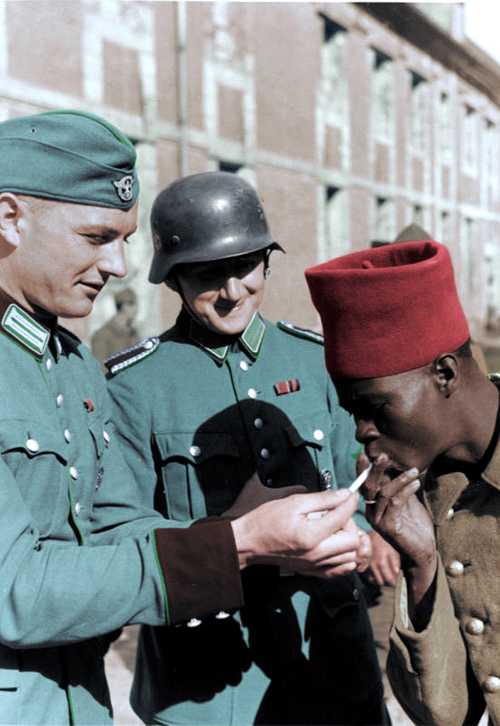
Colorizations By Users
Ordnungspolizei and French Colonial POW (col.)
Two members of the German Schutzpolizei light a French colonial soldier's cigarette. France, May/June 1940. With the outbreak of war, the German Ordnungspolizei formed a considerable number of rifle battalions (sources tell of a number above 80, probably very close to 100), each consisting of more than 500 men. These were sent out of Germany to operate behind the front line combat units of the Wehrmacht. Their main tasks were preventing partisan activity and sabotage, removing weapons and abandoned military equipment, rounding up POWs, securing lines of communication, guarding installations, and generally maintaining law and order. The standard Police tunic was cut from grey-green wool, with contrasting dark brown collar and cuff facings. The collar, cuffs, front edge and rear skirt panels of the tunic were piped in Truppenfarbe (branch of service colour, the equivalent to the military Waffenfarbe). In this case the bright 'police-green' can clearly be seen, identifying this two men as Schutzpolizei (des Reiches). Both men have a rank no higher then NCOs, as shown by the collar patches edged with a narrow silver-grey cord all around, this cord being absent in Officers. The middle soldier seems to be either a Wachtmeister or a Oberwachtmeister, as shown by his shoulder straps. Only from 1941 onwards did the shoulder straps allow to differentiate between these two ranks, with the addition of a piece of extra cord to the base of the shoulder strap for Oberwachtmeisters. To know with absolute certainty the correct ribbon bars wore by this 2 policemen, one would have to have access to their service records. An impossibility in this case, nevertheless some extrapolations are possible, so based on the info available, the following provisional ribbon bar's choices were made: Both soldiers are wearing the Anschluss Medal, awarded to those that took part in the annexation of Austria. Although no thin black bands are visible, these could easily 'disappear' when surrounded by the light reflecting on the white parts of the ribbon. The Westwall Medal was also a possibility, but was excluded because it didn't fit the order of precedence. The middle soldier's second ribbon: The 2 dark bands with a middle band of a lighter colour has one match, the Sudetenland Medal, awarded to German and Ethnic German citizens, military and civilians, who participated in the occupation of that territory in March 1938. Note: A 'cold light' filter was applied to mimic the general cold tones characteristic of German colour photography of the period (Bundesarchiv examples used as reference), these should not be confounded with the artificially colour-saturated photos published in period magazines such as Signal. b&w original property of: Bundesarchiv (Bild 121-0417) A sample of the references consulted: (Original colour plates): Bundesarchiv, in particular: R-165-Bild-244-46, Bild-GD-47, Bild-GD-55. Published sources: " Blitzkrieg Vol.2 - France, Holland and Belgium 1940-1941"; Fowler W.; Alan Publishing, 2002. "German Military Police Units 1939-45"; Williamson G. & Volstad R.; Men-At-Arms (213); Osprey Military. "German Security and Police Soldier 1939-1945"; Williamson G.; Warrior Series (61), Osprey Publishing. "Hitler's Army, 1939-1945: The Men, Machines and Organization"; Stone D.; Zenit Press, 2009. "The French Army 1939-45, Vol.1 - The Army of 1939-40 & Vichy France"; Men-At-Arms Series, Osprey Military. "The German Home Front 1939-1940"; Davis, Brian L.; Elite (157); Osprey Publishing. "World War Two German Police Units"; Williamson G. & Embleton G.; Men-At-Arms (434); Osprey Publishing.
5212 Views
6/17/2013
